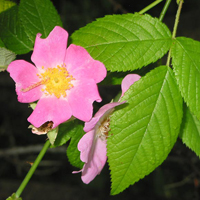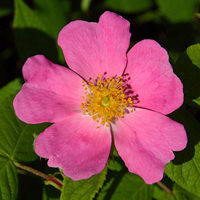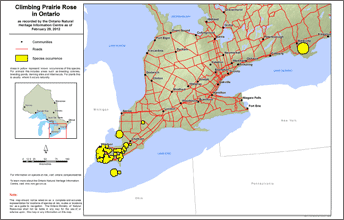Climbing prairie rose
Scientific name: Rosa setigera


Cover photos credit: Allen Woodliffe (all photos)
Status
Special Concern
“Special Concern” means the species lives in the wild in Ontario, is not endangered or threatened, but may become threatened or endangered due to a combination of biological characteristics and identified threats.
Date added to the Species at Risk in Ontario List
The Climbing Prairie Rose was already assessed as a species of special concern when the Endangered Species Act took effect in 2008.
What it looks like
Climbing Prairie Rose is a perennial vine-like shrub in the rose family. Its arching or climbing branches are often several metres long. Arching branches that touch the ground may root at the tips where new plants then develop.
This shrub has alternate compound leaves. The leaflets are opposite and number three to five per leaf. The large flowers have five petals, each two to three centimetres long. The petals are pink and many yellow stamens occur at the flower center. Flowers bloom from late June through July. The fruit (hips) are orange to red in colour.
Where it lives
The Climbing Prairie Rose is typically found in open habitats with moist heavy clay to clay-loam soils such as old fields, abandoned agricultural land, as well as prairie remnants and shrub thickets. This rose depends on areas being kept open by periodic fire or other disturbances.
Where it’s been found in Ontario
View a larger version of this map (PDF)
What threatens it
Since Climbing Prairie Rose colonizes clearings and edge habitats, it will always have a patchy and changing distribution. It is possible that with the increased fragmentation of forests and resulting increases in edge habitats, the species has benefited in some areas. However, only 68 of over a hundred recorded occurrences in Ontario are believed to still exist, and many of these are not considered viable.
Threats include land development, intensive agricultural practices, inappropriate management of conservation areas and roadsides, unrestricted recreational use of all-terrain vehicles, and invasive exotic shrubs (i.e. Autumn Olive).
Action we are taking
Special concern species do not receive species or habitat protection.
What you can do
Report a sighting
- Report a sighting of an endangered animal or plant to the Natural Heritage Information Centre. Photographs with specific locations or mapping coordinates are always helpful.
Volunteer
- Volunteer with your local nature club or provincial park to participate in surveys or stewardship work focused on species at risk.
Be a good steward
- Private land owners have a very important role to play in species recovery. You may be eligible for stewardship programs that support the protection and recovery of species at risk and their habitats.
- Climbing Prairie Roses are pollinated by flying insects. Pollinators are in steep decline across the globe and they play a key role in the survival of many of Ontario’s rare plants. For information on how you can help scientists monitor pollinator populations in Ontario visit: www.seeds.ca/proj/poll.
- The Carolinian forests of southern Ontario support an amazing diversity of plants and wildlife, including many species at risk. Carolinian Canada is working to help recover species at risk and their habitats. For more information, visit: www.carolinian.org/SpeciesHabitats.htm.
Report illegal activity
- Report any illegal activity related to plants and wildlife to 1-877-TIPS-MNR (847-7667).
Quick facts
- Climbing Prairie Rose is dioecious (having male and female reproductive structures on separate plants), which is unusual for rose species.
- Climbing Prairie Rose is a component of the open habitats of the Carolinian Zone, Ontario’s most threatened ecological region with over 125 species that are considered vulnerable, threatened or endangered.
- Climbing Prairie Rose is the only native climbing rose in Canada.
